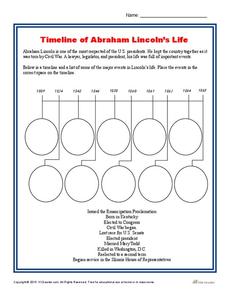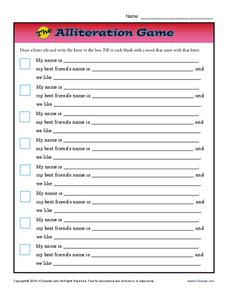K12 Reader
Valentine’s Day Adjectives and Adverbs
Connect parts of speech with Valentine's Day in an engaging grammar worksheet with a Valentine theme. Learners fill in the blanks with the appropriate adjective or adverb to complete each sentence.
K12 Reader
Valentine’s Day Nouns and Verbs
Valentine's Day vocabulary is featured on a fill-in-the-blanks activity. Young grammarians supply the correct noun or verb to a series of sentences.
K12 Reader
Valentine’s Day Word Search
Want another puzzle for your Valentine celebration? Check out a colorful word search that features words related to the holiday.
K12 Reader
The Secret Admirer
What happens next? Use a Valentine's Day writing prompt to encourage kids to create a story that identifies the secret admirer who has left a gift on the doorstep. What is the gift and who is it for?
K12 Reader
Timeline of Abraham Lincoln’s Life
How many moments from Abraham Lincoln's historic life and presidency can your pupils describe?As part of their study of Abraham Lincoln, class members create a timeline of important events in this life.
K12 Reader
Remembering Abraham Lincoln
As part of their study of the contributions of Abraham Lincoln, class members design their own memorial for this great president.
K12 Reader
African American Freedom Fighters Word Search
An informative word search includes the names of six famous African American civil rights leaders. The list includes Rosa Parks, Sojourner Truth, Martin Luther King, Jr., Harriet Tubman, and Frederick Douglass.
K12 Reader
Writing Valentine Poetry
The rose is red, the violet is...what comes next? Write a beautiful Valentine's Day poem based on the rhyme scheme and format of "The Valentine" by Joseph Ritson.
K12 Reader
Robert Burns’ Poetry: A Red, Red Rose
Regional dialect can make a lovely poem even more beautiful. After translating the Scots words in "A Red, Red Rose" into modern English, class members identify the two similes Robert Burns uses in his poem.
K12 Reader
Edgar Allan Poe’s Mystery Valentine
Riddle me this! As part of a Valentine's celebration, class members are challenged to find the key to solve the riddle in Edgar Allan Poe's Valentine poem.
K12 Reader
An Interview with President Lincoln
What would you ask Abraham Lincoln if you had the chance? Class members draft interview questions for the 16th U.S. President, and imagine what his responses would be.
K12 Reader
Abraham Lincoln Bio Poem
Everyone knows about Abraham Lincoln as a historical figure, but what was he like as a person? Young historians complete a biopoem about Lincoln, including his character traits, his relationships, his fears, and his needs.
K12 Reader
Point of View: Who Is Telling the Story?
See how famous books of literature have different perspectives with a short activity. After reviewing the difference between first and third person points of view, learners look over six passages from various novels and decide which...
K12 Reader
Narrator’s Point of View Flow Chart
How can you tell what point of view a narrator is using, and why does it matter when reading or writing? Use a handy flow chart to determine whether or not your narrator is telling the story from a first or third person point of view.
K12 Reader
Change the Point of View: Third Person to First Person
Use Jack London's The Call of the Wild to help young writers learn the difference between first and third person points of view. After they read a passage from the novel, they rewrite it in the first person point of view.
K12 Reader
Narrator and Point of View
Point of view is important when choosing a narrator. Help young writers distinguish between first and third person point of view with an activity that features excerpts from Robert Louis Stevenson's Treasure Island. After reading...
K12 Reader
Change the Point of View: First Person and Third Person
How is a story different when told from various points of view? Learn about first and third person points of view with an activity based on Robert Louis Stevenson's Treasure Island. Readers examine a passage written in first person,...
K12 Reader
Adding Alliteration to Poetry
Alliteration can make the language of a poem flow. Add adjectives to several blanks in two poems to form alliterative phrases.
K12 Reader
Alliteration and Tongue Twisters
Did she sell seashells by the seashore, or did Bill buy berries by the ballpark? Practice literary skills with an activity based on famous tongue twisters. Kids replace the nouns, verb, and adjectives in two phrases to create a new...
K12 Reader
Alliteration: It’s a Zany Zoo!
Elephants eat and cheetahs chase in this zany zoo! Kids survey a list of ten animals before adding in an adjective and verb for each to form an alliterative phrase or sentence.
K12 Reader
Warm Up to Alliteration!
How can you tell if a sentence has alliteration? Use a short worksheet to help kids identify examples of alliteration, complete sentences to create alliteration, and use nouns to write their own alliterative sentences.
K12 Reader
Adventures with Alliteration! - Nouns
Create poetry with a worksheet based on alliterative phrases. After reviewing ten nouns, kids add an adjective to each based on the first letter of the noun. They then rewrite five sentences to involve more alliteration.
K12 Reader
Alliteration Animals
Bees buzz, dogs dig, lion laze, and snakes slither! Use alliteration to create sentences about four different animals.
K12 Reader
Alliteration Game
Practice alliteration with a fun game! Kids match names to a best friend's name, and add something they both like.























